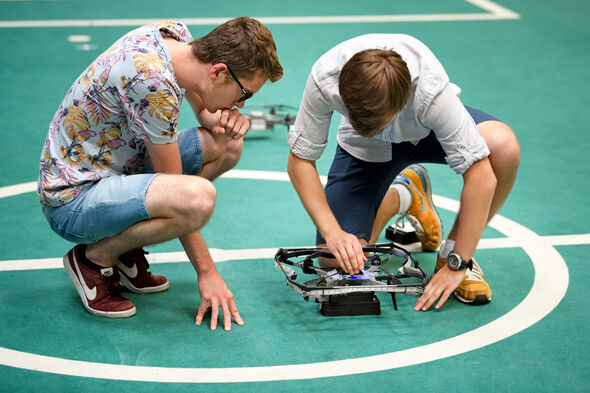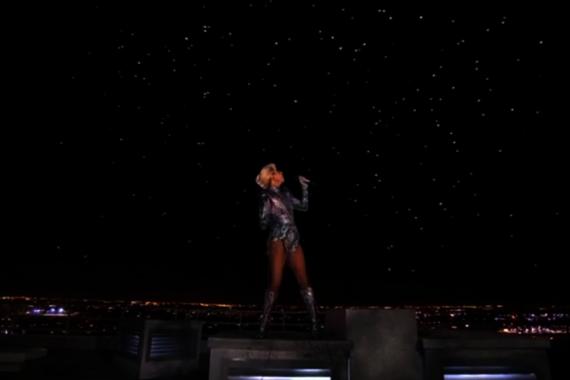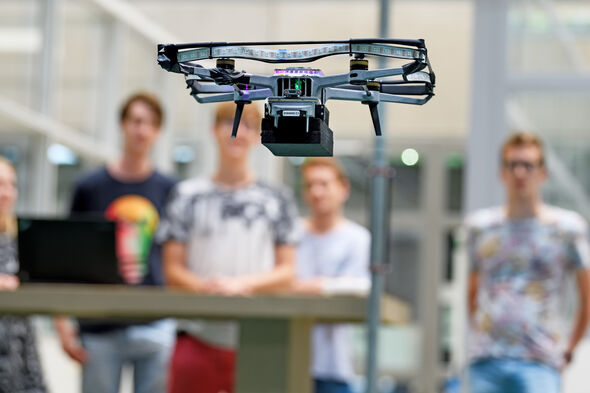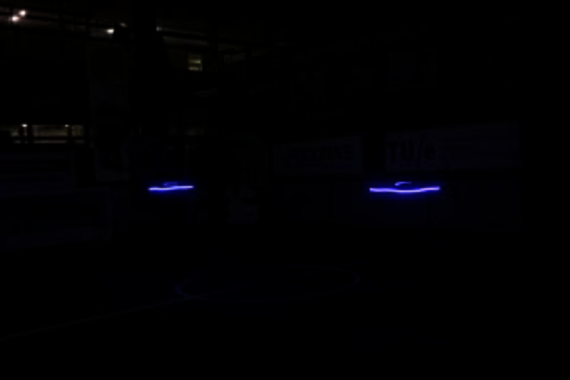![[Translate to English:]](/fileadmin/_processed_/d/8/csm_BvOF_Firefly_1_84d5ae9972.jpg)
- Student
- 05/07/2018
TU/e students develop light show with drones for GLOW
At GLOW this coming November a team of TU/e students hopes to put on a light show involving drones. Technically speaking this is feasible, says Peter van Dooren of team Firefly, but it presents some organizational challenges that still have to be overcome.
Team Firefly came into being through the honors track High Tech Systems, in which second-year students have the opportunity to choose a project they want to work on for a year. In fact, the organizers of GLOW had approached Blue Jay (a couple of years ago) about producing a show for the light-art festival, but that team already had its hands full developing drones with other applications, knows Van Dooren.
After that, the request landed with the research group Control Systems Technology, more specifically with Assistant Professor Duarte Guerreiro Tomé Antunes. Van Dooren: “He thought it was something for us.” And that view was shared by roughly half the honors student on the track mentioned above, all of whom were keen to take up the artistic challenge (others joined a second honors project, focusing on autonomous race drones).
By the end of the project year, reports Van Dooren, now a Master's student of Systems and Control, a proof of concept had been produced “using some cheaper drones and some shop-bought LED lights we attached to them”. And that was enough to whet the appetite of some of the students involved: Firefly was born. At present the team comprises sixteen active student members, all part time. Some are students whose enthusiasm has kept them involved even though they have completed their honors track; others have joined the honors track more recently.
Read on below the photo.
Team leader Van Dooren is no exception. The creative and free-form nature of the challenge appealed to him, and the cooperation with artists and Avular is spiking his interest. The latter, an Eindhoven startup that develops platforms for mobile robotics, has supplied the drones with which Firefly is working.
No GPS
The positioning of these flying machines presents - understandably - one of the greatest challenges in putting together a light show involving drones. “Most drones use GPS but we don't; we mostly fly indoors.” So Firefly is making use of ultra-wide band, which a drone can use (based on tags on the drone and in the surrounding area) to determine its position.
This positioning system used by the drones (illuminated with multicolored LEDs) to guide themselves will also be used during the planned light show to enable the drones to create an ever-changing artistic work of light. “A video screen of sorts will be placed on the floor. Above it we'll have the drones flying around autonomously, and their movements will 'paint' patterns on the screen. So the position of the drone will serve as a paintbrush of sorts.”
Although the show will be complemented by music, the drones won't be dancing to the beat. Van Dooren explains: “A drone's control system is very sensitive; just imagine balancing a stick on your hand. Try doing that while staying in step with the music. It's very difficult because you constantly need to make small corrective movements to keep the stick balanced. Consequently you are always just a little ahead of the beat, or lagging behind a fraction; the audience would spot that immediately.”
Super Bowl
To start with, Firefly is keen to put on a show involving three drones. This may seem scant considering the large-scale drone shows already held at, say, the American Super Bowl and the opening of the Olympic Games in South Korea. Van Dooren: “Intel for example puts over a thousand drones into the air, so many that as an audience member you can hardly tell they are drones. We want our show to be at close range and to let our public see, among other things, the unique way drones move.”
Read on below the video.
This close proximity, particularly where GLOW is concerned, does present some practical and organizational challenges. For example, the need for a suitable and safe location on the (already established) route, “preferably where passersby can see the drones immediately without having to step into an enclosed area.” This means their participation in this year's GLOW is not yet absolutely certain, “but technically we are ready for it - even though there is still plenty to be improved and tightened up.”
In addition to all this, light artists Michel Suk and Adriaan Wormgoor will be providing their artistic input; Suk for GLOW, Wormgoor for the expo Robot Love, where Firefly definitely will be on show this fall. They have both previously worked with drones, “so they know a bit about the technical ins and outs and what's possible”. For Robot Love the makers initially have in mind “something intimate, whereas for GLOW a spectacle is very much required. At GLOW, we are hoping to give people a true ‘wow’ experience that hits you all at once.”
WALL-E
For now, Firefly is focusing on the two events mentioned above; after that the future is wide open, says Van Dooren. Official status as a student team or a possible follow-up as a commercial startup are not yet on the cards, according to the team leader, “right now the main thrust of our plan is to keep the project as part of the honors track. But if there's enthusiasm for these options, we'd be happy to work towards achieving them. Personally, I think it would be really interesting to give a drone something of a personality. Look at WALL-E (the little robot in the Pixar films of the same name, ed.) with his entirely unique character. I think it would be great to do the same with drones and to use that as a way to help people connect with them.”




Discussion